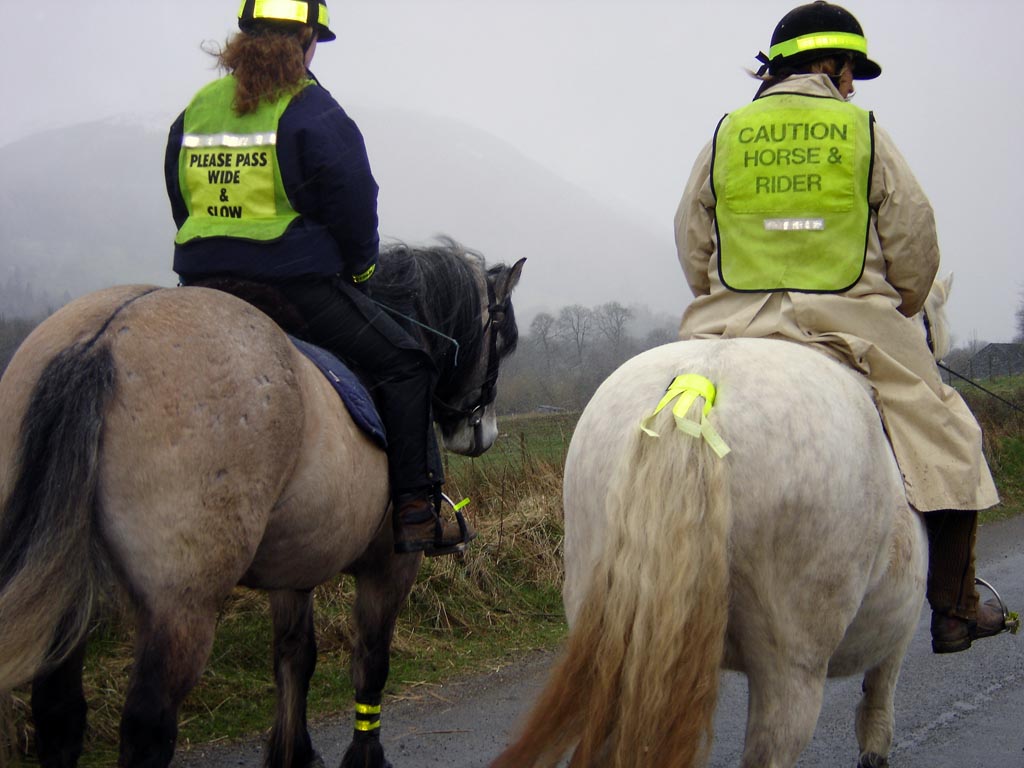Here in the National Park, we’ve got pretty much every category of road user — bikes, bicycles, cars, walkers, horses and the occasional tap-dancing Pine Marten, all trying to do their own thing at their own speed, and often at the same time. While there’s a wider concern about how all of these can share the roads (in like peace, light and harmony, man…) the technique for passing large, hairy quadrupeds does seem to cause some stress amongst all parties. So here, reprinted with the author’s permission from our local community rag is a small plea on behalf of horsey folk everywhere:
“For those many non-horsey people, that “Please Pass Wide and Slow” fluorescent tabard (or similar) you may well have seen moving along a country lane, is not meant to describe the obstacle in front of you — the rider is actually asking for your consideration in safely passing the horse, for both your safety and theirs.
Horses are ‘flight’ animals, meaning they would rather run than stand and fight, and, as with any domesticated animal, are slightly unpredictable. High speeds of approach, revving engines, honking and not allowing much space when passing could well spook a horse — and then you or another road user could well be faced with a half-ton panicked animal looking for an easy escape route, and not all horses are natural jumpers!!
Country lanes are in use by us all; on foot, with children, dogs, on bikes or horseback and in vehicles of all sizes — and we DO need to respect each road user. If you find horses in your path, two-a-breast, we are not catching up on local gossip (only!) but we are trying to make ourselves as visible as possible and attempting to slow vehicles approaching our animals, before passing.
Bemused cyclists who have come up behind a horse and rider may well wonder why we ask that they “say something” whilst approaching. Again, this is purely for safety, as horses generally cannot hear bikes. The sudden appearance of something moving up behind them, without warning, is as frightening to them as a preying animal (natural instincts are in us all!) — however, horses are bright enough to acknowledge that it probably isn’t dangerous if it sounds ‘human’.
The Lothian & Borders Police Road Safety Unit held a meeting with the British Horse Society at the end of last year, and a staggering statistic came to light – “64% of all road deaths happen on roads regarded as rural and therefore quiet”.
PLEASE don’t add to that statistic — give considerations to horses and all other road users in our beautiful glens and don’t ruin your day or anyone else’s because you couldn’t be bothered to briefly slow down for that ‘obstacle’ in front of you.
Thought for the day: When sitting on a ‘FLIGHT’ animal, believe us — we want you to pass us and not crawl along behind us… …but SAFELY, for all our sakes.
With thanks for reading this,
from B.R.A.- the Balquhidder Riding Association.” — Thanks there to Tanya and Karen for words and picture.
Can’t say fairer than that, to which I’ll add my own observations that motorcyclists are probably a horse’s worst nightmare: fast, loud and sudden (and the bikes themselves aren’t much better…). If coming up on a horse or group of horses, do slow down a long way in advance, give yourself time to check them out and ask yourself: have they obviously heard you coming? do any of the animals (and/or riders) look nervous? are they changing formation in anticipation of your passing? If in any doubt whatsoever, wait until you’re sure that they’re aware of you and that the party is composed and ready for you, then pass as above — wide and slow. If you’re approaching them from the front and on a narrow road, you might even be advised to pull over, shut the engine off and wait until they’re well past before lighting up again — I tend to do this as I’ve noticed that twins such as Ducatis and BMWs seem, at low revs, to cause more equine consternation than fours.


Leave a Reply